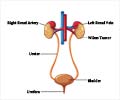Freezing kidney tumors—using a safe minimally invasive interventional radiology treatment that kills the cancer 100 percent effectively without surgery—should...
Freezing kidney tumors—using a safe minimally invasive interventional radiology treatment that kills the cancer 100 percent effectively without surgery—should be the gold standard or first treatment option for all individuals with tumors that are 4 centimeters in size or smaller. And, this treatment—interventional cryoablation—is a viable option for people with larger tumors, according to two studies presented at the Society of Interventional Radiology's 34th Annual Scientific Meeting.
"Interventional cryoablation is as effective as laparoscopic surgery (partial nephrectomy), the current gold standard treatment, and laparoscopic cryoablation surgery for treating renal cell carcinoma," said Christos Georgiades, M.D., Ph.D., interventional radiologist at Johns Hopkins Hospital in Baltimore, Md. "We can eliminate a cancer—that once it metastasizes can be notoriously difficult to treat and has a low chance of cure—with a simple outpatient procedure. Eliminating cancer at such an early stage is truly significant news for kidney cancer patients," he added.It's important that individuals realize all their treatment options—especially since the incidence of kidney cancer has been steadily increasing in this country over the past 30 years, said Georgiades. Approximately 54,000 people are diagnosed with kidney cancer each year—with nearly 13,000 dying from it annually, according to recent statistics. Most people with this cancer are older, and the overall lifetime risk of getting kidney cancer is about 1 in 75—with men at higher risk than women. More than 75 percent of individuals who are diagnosed with kidney cancer have small tumors that are discovered incidentally. "Cryoablation is a great treatment option that doctors should discuss with patients early on," he explained.
The Hopkins studies, examining the safety and efficacy of percutaneous (no incision) cryoablation, show the treatment's powerful results. "Based on the results of our three-year study, we have shown that interventional cryoablation for kidney cancer should be the gold standard or the first treatment option for all patients whose tumors are 4 centimeters or smaller. It should be a viable option for patients whose cancer is even larger than that. And, ablation (or freezing) is a very effective option for patients who cannot or do not want to have surgery," noted Georgiades. Cryoablation's efficacy rate—the ratio of how many patients' renal cell carcinoma was destroyed completely for localized tumors by size—is 100 percent up to 4 centimeters (about 2 inches) and nearly 100 percent up to 7 centimeters (about 3 inches). Three localized 10-centimeter (about 4 inches) tumors—large tumors that are typically removed surgically—were treated; in two cases the tumor was successfully killed.
"This news is especially significant for individuals with small tumors, since more than 75 percent of patients who are diagnosed with kidney cancer have tumors that are 4 centimeters or less in size," said Georgiades. "These individuals can have their tumors treated completely, effectively, without surgery, with quicker recovery and mostly on an outpatient basis. Whatever the definition of 'cure' is, these results come as close to it as possible," he noted. "At Hopkins, interventional cryoablation is the first-line treatment for small tumors.
Most of our patients go home the same day they receive treatment with minimal limitation on regular activities. With laparoscopic kidney surgery, a patient remains in the hospital for several days and recovery time can be from two to four weeks," he added. "Our studies highlight how effective interventional radiology treatments can be—not just for kidney cancer—but for other kinds of cancers and other diseases as well. Interventional radiology treatments will have a significant impact on the overall survival and benefits that patients can have from avoiding surgery," said Georgiades.
"There is no question that interventional cryoablation, which uses imaging to pinpoint tumors and probes to penetrate the skin to deliver freezing cold directly to a diseased tumor, works. This interventional treatment is not a widely known procedure yet, even to other doctors, and some patients are going to have to pursue it on their own," said Georgiades. The treatment is widely available in the United States at all major institutions and some smaller institutions as well; it is usually covered by health insurance.
"Traditionally, laparoscopic surgery has been the main treatment option for all renal cell cancers; it literally cuts the cancer out. The good news is that individuals no longer need to have a kidney partially or completed removed to treat their cancer," noted Georgiades. When comparing the rate of complications between percutaneous cryoablation and surgery, Georgiades said that none of the patients who had cryoablation developed new or metastatic disease and they had fewer complications. The minimally invasive nature of interventional cryoablation means that it can be performed with minimal blood loss and without an incision, just a tiny hole in the skin. The interventional radiology treatment translates into significantly less pain, a shorter hospital stay and more rapid recovery. This safe treatment can be repeated, if necessary. The most common complication is a bruise around the kidney that goes away by itself, he said.
In studying cryoablation's safety, Georgiades studied the results of 101 percutaneous cryoablations on 91 patients who either couldn't undergo surgery or elected the interventional radiology treatment. Using computed tomography (CT) imaging, researchers could view tumors and probes in real time. Interventional cryoablation "has an excellent safety profile," said Georgiades.
Cryoablation is typically performed under light anesthesia, known as sedation, by an interventional radiologist who has consulted with the patient's urologist. One or more hollow needles are inserted through the skin directly into a tumor. Interventional radiologists can observe and guide the insertion by combined use of ultrasound and CT. The needle, or cryoprobe, is filled with argon gas, which creates an ice ball, which rapidly freezes the tumor. The tumor is then thawed by replacing the argon with helium. The procedure consists of two freezing and one thawing cycle, seeking a frozen margin beyond the tumor edge to ensure death of the entire tumor. After the cryoprobe is removed, a small bandage is placed over the skin puncture site. Cryoablation, which can also be referred to as cryo or cryotherapy, is approved by the Food and Drug Administration for treating soft tissue tumors, such as renal cell cancer.
Source-Eurekalert
SRM















